#Cryogenic Fuels
Explore tagged Tumblr posts
Link
Proton-exchange membrane fuel cells (PEMFC), which are being developed for use in electric vehicles, rely on nanoparticles called catalysts to trigger electricity-producing reactions between hydrogen and oxygen. Most PEMFC catalysts contain platinum -- a scarce and precious metal. There is therefore a pressing global need to develop catalysts that can generate the most power while minimizing platinum content.
Manufacturers integrate these catalysts in complex assemblies called catalyst layers. Until now, they had to do so without a detailed picture of the resulting structure, as traditional imaging processes almost always cause some degree of damage. Vasiliki Tileli, head of the Laboratory for in-situ nanomaterials characterization with electrons in the School of Engineering, has found a way around this challenge. By imaging catalysts and their environment at below-freezing temperatures using cryogenic transmission electron tomography and processing the images with deep learning, she and her colleagues have succeeded in revealing, for the first time, the nanoscale structure of catalyst layers.
"We're still far away from PEMFCs without platinum, which is very expensive, so in the short term, we need to reduce platinum loading to make this technology viable for mass production. It's therefore imperative to understand how platinum sits in relation to other materials within the catalyst layer, to increase the surface area contact required for chemical reactions to take place," Tileli explains.
Read more.
#Materials Science#Science#Fuel cells#Membranes#Nanoparticles#Catalysts#Platinum#Nanotechnology#Surfaces#Reactions#Materials Characterization#Cryogenics
9 notes
·
View notes
Text
Low Leakage Cryogenic Disconnects for Fuel Transfer and Long-Term Storage
To enable deep space missions, the capability to transfer and store cryogenic fuels (typically liquid hydrogen, methane, and oxygen) without significant leakage over long duration missions is critical. NASA has been actively developing zero boil-off cryocooler technology to reduce storage losses. Another source of fuel loss is from leakage at the fuel disconnect used for in-space refueling. […] from NASA https://ift.tt/yHnASbz
#NASA#space#Low Leakage Cryogenic Disconnects for Fuel Transfer and Long-Term Storage#Michael Gabrill
1 note
·
View note
Text
Heartbreaking: this girl’s family thinks space travel and zero-gravity is scary
#hiiii making the family watch interstellar#and while i sit there watching the astronauts with envy my mom n sibling r like ‘this is nightmare fuel’#okay like i get thinking the cryogenics are scary but the space travel itself?? the zero g??#that’s fuckin AWESOME#chatter
1 note
·
View note
Text
Global Cryogenic Fuels Market Size, Share, Growth Analysis, By Product Type(LNG, hydrogen), By Distribution Channel(Direct sales, distributors)
Global Cryogenic Fuels Market Insights
Global Cryogenic Fuels Market size was valued at USD 105.6 billion in 2021 and is poised to grow from USD 112.04 billion in 2022 to USD 179.93 billion by 2030, growing at a CAGR of 6.1% in the forecast period (2023-2030).
Cryogenic fuels are fuels that are cooled to extremely low temperatures so that they can exist in a liquid state. The most common cryogenic fuels are liquid hydrogen (LH2) and liquid oxygen (LOX). These fuels are used in rocket engines because they provide high thrust with relatively low weight. Cryogenic fuels are stored in tanks that are heavily insulated to keep the fuel at its low temperature. Liquid hydrogen must be stored at a temperature of -253°C, while liquid oxygen must be stored at a temperature of -183°C. The use of cryogenic fuels is essential for space travel, as they provide the high thrust needed to escape the Earth's gravity and reach orbit. In addition to rocket engines, cryogenic fuels are also used in some high-performance aircraft engines and in some industrial processes that require extremely low temperatures.
The global cryogenic fuels market is expected to experience significant growth in the coming years, driven by various factors. The world is moving towards a low-carbon economy, and there is a growing demand for clean energy sources such as LNG, hydrogen, and biogas. Cryogenic fuels play a critical role in the production, transportation, and storage of these fuels. Industrial gases such as nitrogen, oxygen, and argon are used in various industries, including healthcare, food and beverages, electronics, and chemicals, among others. The growing demand for industrial gases is expected to drive the demand for cryogenic fuels in the future. Technological advancements in cryogenic storage and transportation are driving the growth of the global cryogenic fuels market. The development of advanced cryogenic storage tanks and transportation systems has improved the efficiency and safety of cryogenic fuel transportation. The development of infrastructure such as LNG terminals, pipelines, and storage facilities is expected to drive the growth of the global cryogenic fuels market. The construction of new infrastructure will increase the availability and accessibility of cryogenic fuels. Governments around the world are implementing policies and regulations to promote the use of clean and sustainable energy sources. This is expected to drive the demand for cryogenic fuels in the coming years. The shipping industry is adopting LNG as a marine fuel due to its low emissions and cost-effectiveness. This is expected to drive the demand for cryogenic fuels in the marine sector.
Global Cryogenic Fuels Market Segmental Analysis
Global Cryogenic Fuels Market is segmented on the basis of product type, distribution channel and region. By product type, the Cryogenic Fuels Market is segmented into LNG, hydrogen, oxygen, nitrogen, and others. By distribution channel, Cryogenic Fuels Market is segmented into direct sales, distributors, and online sales. By region, the Cryogenic Fuels Market is segmented into North America, Europe, Asia Pacific, Middle East and Africa, and Latin America.
Cryogenic Fuels Market Analysis by Product Type
The dominating segment in the global cryogenic fuels market based on type is the LNG (Liquefied Natural Gas) segment. LNG is the most commonly used cryogenic fuel due to its high energy density, low emissions, and ease of transportation. The demand for LNG is increasing globally due to the growing demand for natural gas as a fuel for transportation and power generation. In addition, the increasing adoption of LNG as a marine fuel is also contributing to the growth of the LNG segment.
The fastest growing segment in the global cryogenic fuels market based on type is the hydrogen segment. Hydrogen is a clean-burning fuel that emits only water vapor and can be produced from a variety of sources, including renewable energy sources. The increasing focus on reducing greenhouse gas emissions and the shift towards a hydrogen economy are driving the growth of the hydrogen segment. The use of hydrogen as a fuel for fuel cells, transportation, and industrial applications is expected to increase significantly in the coming years, driving the growth of the hydrogen segment in the cryogenic fuels market.
Cryogenic Fuels Market Analysis by Distribution Channel
The direct sales segment is expected to dominate the market due to the increasing demand for customized solutions and direct communication between the manufacturer and end-user. Direct sales involve the sale of cryogenic fuels directly from manufacturers to end-users such as industrial gas companies, energy companies, and transportation companies. This distribution channel is preferred by large end-users who require a high volume of cryogenic fuels and have the resources to handle logistics and transportation.
Distributors act as intermediaries between manufacturers and end-users. They purchase cryogenic fuels in bulk from manufacturers and sell them to end-users such as hospitals, research laboratories, and welding companies. This distribution channel is preferred by small to medium-sized end-users who require smaller quantities of cryogenic fuels and do not have the resources to handle logistics and transportation.
0 notes
Text
Did you know that NASA engineers considered the failure rate of some critical shuttle parts to be about 1 in 100 (significantly greater than what NASA upper-management considered the failure rate to be, and what was considered at all acceptable by the certification process)?
Do you know that NASA engineers currently have no idea how many rocket launches the next mission in the Artemis program (in 2 years!) is meant to involve, because the mission plan relies on SpaceX being contracted to deliver a supply of cryogenic fuel to the crewed Orion (™ Lockheed-Martin) capsule in orbit - a procedure that 1: has never been attempted before on any spacecraft, let alone the Orion™ capsule, not even in uncrewed technology demonstration flights; and 2: would require an as-of-yet unknown number of SpaceX 'Starship' launches, because said vehicle does not actually exist at time of writing?
Did you know they're planning on using this 'starship' as the crewed lander? A design for a lunar ascent vehicle, that is, that does not use hypergolic fuel, that relies on a swing-out crane as the only entry and egress point? During the original moon landings, the LEM had so many redundant methods to make sure it got astronauts off the surface of the moon, that in the most absurd, extreme case, where every single mechanism fails, there's a procedure trained into the astronauts to climb around the outside of the capsule, take a pair of bolt-cutters from the equipment box, physically cut the couplings holding the capsule to the lander stage, and take off to get home. Artemis' proposed lander, on the other hand, is planned to be a vehicle whose design didn't even include heatshields until it was realised it would obviously need heatshields, which are ceramic tiles bolted after-the-fact directly through the steel hull, because SpaceX had decided to mass-produce the original-design hull sections all at once for all the 'starships' first, before doing any integrated testing.
We're seeing the exact attitude that led to the shuttle disasters not being prevented now expressing itself in (and even through) the Artemis program, a project pushed harder and faster through the gates than it should be, by a government (and NASA administration thereby) desperate to advance the eponymous Artemis Accords (that goes unsigned by China, Russia, and much of the world) and reneg on all previous space charters that onsidered ownership, commercial exploitation, and military usage of space forbidden. Something bad is going to happen, and it's going to happen for the sake of SpaceX and the military-industrial complex at large.
2K notes
·
View notes
Text
MCSR As Chemical Compounds
idk either man. expect very little actual explanation and a lot of chemical yapping from a very big nerd
Silverr as Silver Nitrate:
AgNO3
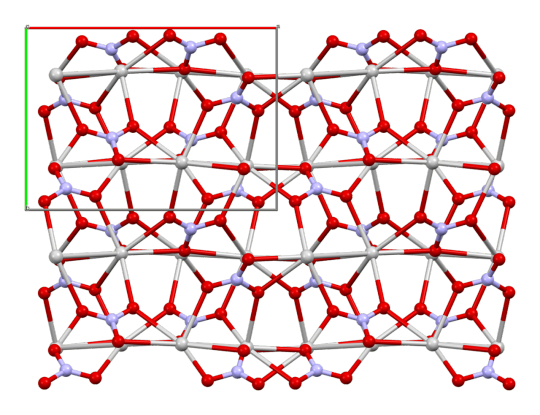
the above is the crystal structure
appearance is just a white crystal kinda like sugar
it took everything in me to not just make silverr plain Ag
silver nitrate is the most common precursor for all other important silver salts
also an extremely important compound in the development of photography! (and iirc silverr is a film major)
Feinberg as Ozone:
O3

produced during lightning strikes
pale blue at high ppm
only leaves gas state at cryogenic temperatures
naturally occurring in the stratosphere and absorbs UV rays from the sun
Fruit as Nickel(II) Chloride Hexahydrate:
NiCl2•6H2O


green
the non-hydrate form is a sort of olive-y yellow color
used to absorb ammonia in gas masks
Raddles as Potassium Permanganate:
KMnO4
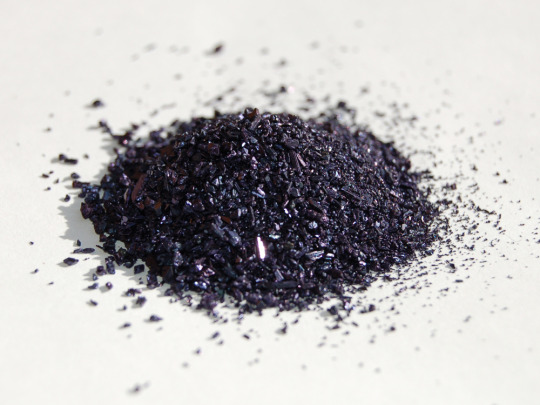

Sometimes referred to as Purple Potion Powder
goes CRAZY purple when dissolved and is lowkey my favorite chemical
very strong oxidizing agent
one time i stained my hand purple through my glove with this shit idk how it happened
if made in specific solvents can look extremely similar to dragon's breath in minecraft imo
K4 as Octathio[8]circulene:
C16S8
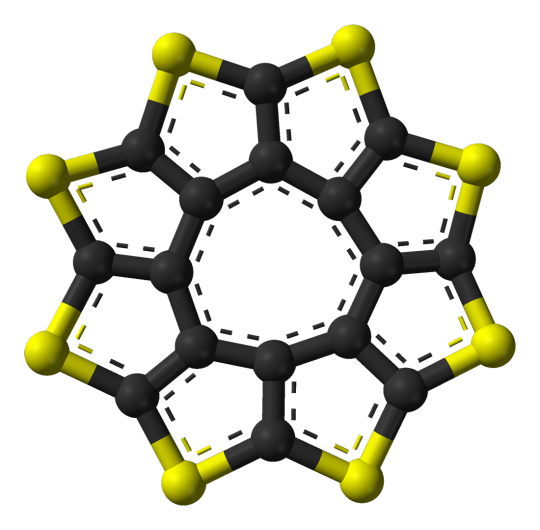
also referred to as Sulflower (like sulfur and sunflower haha get it)
planar which is fairly uncommon for molecules of this size
can be stacked together to make sheets of sulflowers
Cube as Cubane:
C8H8
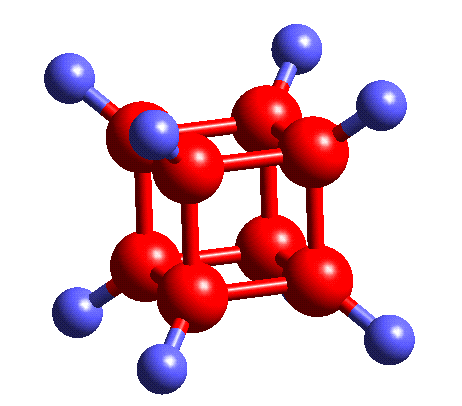
yeah this is self-explanatory
what is interesting though is that ring strain in 4 membered rings/squares is really high, so cubane existing is a bit of a chemical anomaly
i havent read into it enough to know for sure but i suspect that ring strain is why cubane is a precursor to a HELLA STRONG explosive compound
Reignex as PPTA:
Poly-p-paraphenylene terephthalamide
[-CO-C6H4-CO-NH-C6H4-NH-]n

the name is complicated as shit but this is just kevlar!
aka bulletproof vest material
looks fluffy when not woven completely together
aligning of polymer chains w hydrogen bonds creates EXTREMELY high tensile strength
Mime as Phenylmagnesium Bromide:
C6H5MgBr

a common grignard reagent aka a compound that can be used in a grignard reaction, an extremely important reaction in organic synthesis as it creates new C-C bonds
another fun fact about grignard reagents is that if water is added to them- or even if they're handled in particularly moist air- they fucking explode
extremely strong nucleophile and base
Poundcake as Xenon Hexafluoride:
XeF6
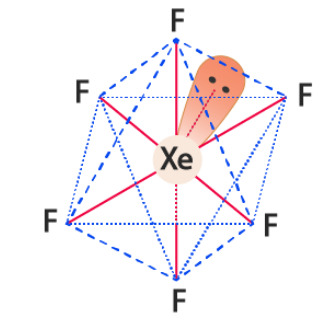
Noble gases don't react unless you REALLY make them
so a compound containing xenon is really interesting
colorless as a solid but sublimes (aka skips straight from solid to gas) into a bright yellow gas
fun fact a lot of instances where typical chemistry rules are broken (noble gases not reacting, octet rule in general, etc) involve fluorine to the point ive heard it referred to as a "batshit electron thief"
Fulham as Iron Hexacyanidoferrate:
C18Fe7N18
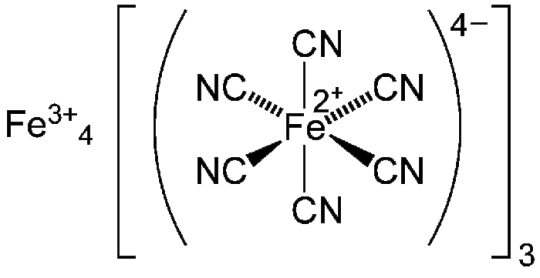
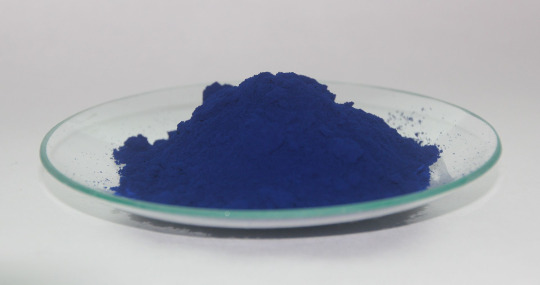
also known as prussian blue
extremely common pigment in paints and the first modern synthetic pigment
used extensively in The Great Wave
another one of my favorite molecules bc im biased and like inorganic chem aka things that contain metals
used as an antidote for heavy metal poisoning which is interesting bc it contains cyanide ligands!
Couriway as Bullvalene:
C10H10
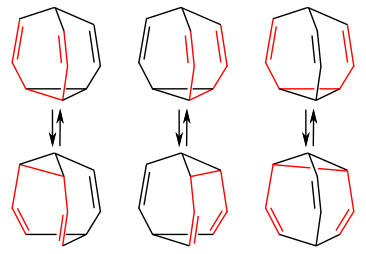
in a state of constant resonance
aka the double bonds are CONSTANTLY shifting and reforming bullvalene into... itself but moved around a little
the bonds fluctuate so rapidly that in nmr analysis each carbon and hydrogen in the entire molecule is read as equivalent (for my non-chem people that's very uncommon and very cool)
formed through photolysis (aka using light/photons to fuel a reaction)
#i made this for me and only me#chemistry is a disease and i will not be getting better anytime soon#90% of these picks are straight soul reads im gonna be so fr#mcsr#hbg#fruitberries#feinberg#couriway#fulham#president poundcake#raddles#silverrruns#reignex#talkingmime#cube1337x#k4yfour
83 notes
·
View notes
Text
Ok so in my fic Slip I vaguely based Hydra off of a DOT-114 tanker because i could find the specification really easily they're sometimes used for pressurised gasses, but GOOD NEWS! I was wrong and also stupid :)
I've been recreationally overthinking this all day, for funsies. The interesting thing is, in Europe we don't really have H2 on the rails in that way yet- DB cargo is doing a lot of work there, but not in any formats that match up with the green bean. We know he doesn't carry ammonia or methanol because his fuel is usable without pre-processing, and we know he's not any sort of MEGC. The only other option in europe is cryocontainers of LH2, but they're intermodal- you can put one on a ship, unload it onto a lorry or a flatbed or whatever, and go about your merry way. so not that neither.
(sidebar: I know he is a creation of andrew lloyd webber's twisted mind and also a twink on rollerskates, but shh. im playing touys.)
The likelier option, imo, is that he's carrying cryogenic liquid hydrogen. This would track with some sliiightly older technologies (and i really do mean slightly) like liquid natural gas, which has already been used in duel-fuel locomotives. At time of writing, the only thing I could scrounge up that's actually authorised for cryogenic hydrogen transport on US rails are DOT-113 tanker cars, which are usually designed for other cryogenic liquids but. Uh. Im sure its fine. Nowt in the UK yet, we've got all of it on the roads at the minute. He's some kind of freaky half-to-spec pilot project to me anyways, I just need to ballpark.
According to the Railway Association of Canada's Railway Emergncy guide, DOT-113A60W tankers have a working temperature of -423F, which is the temperature hydrogen becomes liquid at.
So! That means we're working with DOT-113A60W!Hydra, or at least something similar! :D He's got a tank-within-a-tank system, weather-shielded loading/unloading valves, and DO NOT HUMP OR CUT OFF WHILE IN MOTION stenciled somewhere easy to see. Thank you for coming to my ted talk!
#starlight express#stex hydra#hydra the hydrogen tanker#starlight express london 2024#stex london revival#the Articles#my posts
13 notes
·
View notes
Text
Into the Black With a Matchstick, pt 3
I'm keeping this as the taglist, but feel free to DM/comment/Ask if you want to be added/removed.
Please, if you haven't read the first parts in awhile, check out the recap I have linked for your convenience. :3
@c00kieknight, @jxm-1up, @midnight--architect, @robinparravel, @thepotatoofnopes, @those-damn-snippets; @thelazywitchphotographer, @tildeathiwillwrite
first previous recap
cw: bad math
---
Whatever the fuck the newcomer with Admiral Paxie was, it was not helping Adina's already overtaxed brain.
It had been bad enough seeing that Paxie was so huge they could barely even fit into the ship. It was bad enough that Adina was in charge of probably all that was left of the human race, that she had no way of figuring out if these aliens were truly friendly or just acting like it, bad enough that she was starving and dehydrated and high and had the worst God-damned headache she had ever had in her life.
And now she had to let some six foot tall cave-dwelling-mantis-snake-vampire walk around in the ship. It was like this thing was specifically made to be as creepy as possible, and when it got down on all eights—
She had dropped the ship's remote helm tablet, almost on her foot, and she was still shaking from the heart attack the sudden noise had caused her.
When they got to the bridge, which was thankfully open enough to allow Adina and John to put some space between themselves and the aliens, Paxie pulled the nightmare fuel aside. Adina subtly let out a sigh of relief and busied herself at the control panel.
Frankly, she didn't know what she was looking at. This was John's job. But the drugs in her brain were starting to prove themselves a bad idea as her body's discomfort reared its ugly head, and she couldn't stop thinking. Four times during the walk from the dock she had considered waking up a Marine to protect her and John from these monsters. And that wasn't the mind of a diplomat. That wasn't the thought of a leader she could trust.
Just get through this. Get through this meeting, and then food, water, and real sleep.
The smaller Xoixe stepped up to the LCD screen with most of the interactive display on it. John sidled up, too, probably to make sure Adina didn't hurt anything. Good.
"I heard this ship carries its life-forms cryogenically?" the smaller Xoixe asked. Adina looked up, and as soon as she did, John gently moved her hands and started clicking away at the panel's keyboard.
"Uh, yes," Adina replied. Looking up into the suit made it slightly easier than looking into four eyes and a big, sharp-toothed mouth. Maybe they wouldn't have looked so intimidating if her head wasn't throbbing. "Yes, our crew was specifically picked for the task of determining the viability of another planet for colonization. But the human lifespan isn't long enough to make the trip at our curr — with the technology we had." Adina put a hand to her face, pretending to wipe the sweat on her forehead, seeking the cold relief of her own touch. 26 million years…. "We were only supposed to be space-borne for 150 years…."
"If you don't mind my inquiry," the smaller Xoixe said as John kept typing. Adina looked up. The large alien had sat back on their haunches and was carrying their own tablet, made of a sleek plastic-looking material. "Is it possible for me to acquire standard medical parameters for your species? I'm a xenomedic, but since this is our first encounter, I have nothing to go on."
Adina stared for a moment. A xenomedic. So they'd brought a doctor aboard on their landing party. A group of three, and they'd saved a seat for a doctor. Adina didn't even know what the nightmare's job was, but when she glanced over, she realized there were no weapons on anyone. The nightmare perhaps could have used their claws, but looking again, their limbs didn't seem strong enough to hold Adina or John down if they started throwing punches. Both Xoixes had their claws entirely covered in their suits, and there was no attempt to make the suits sharp on the outside.
So maybe they really were friendly. Or maybe they did a really good job at acting like it. There weren't many ways to tell. Did this species even lie? How inherit was lying for intelligent species? Did Earth animals lie? Yes, Koko the Gorilla had told a lie. Had she learned that from humans?
The Xoixe was staring at her.
"Okay," Adina rasped. "Follow me."
---
"Lieutenant Harrison?" Paxie asked once Captain Ramirez and Ensign Kime were gone. Sergeant Klte shifted behind them, out of view of the little alien. Harrison turned away from the console after a lengthy delay.
These creatures looked more and more like prey the longer Paxie studied them. All except for their forward eyes. It was uncanny. Harrison's eyes were bright and round outside of their black, circular pupil, and it made it all too clear that they were looking directly at Paxie.
"Yes… Admiral?" Harrison said. Paxie shook their head slightly to focus their thoughts.
"Would it be acceptable for Sergeant Klte to take a look around your ship? We're curious as to how your vessel has lasted for so long in open space."
Harrison… laughed again. It was loud and sharp, and they opened their mouth and bared their teeth to do it.
"If you figure that out, I'd like to know, too," Harrison said. Paxie quirked their jaw.
"How do you mean?" Klte moved behind them, too.
"Our ship was meant for a 150 year journey," Harrison explained, still baring their blunt teeth. "Even that was ambitious for our level of engineering." They turned to the console and began hitting buttons. They were small buttons compared to the Xoixe's controls, and they clicked and snapped as they pressed and navigated. "We've made unmanned — that is, autonomous and without organic passengers — bodies before. To go into space. But even those tend to give out after a few decades. A-a group of ten years."
Paxie stepped closer and looked down to the readout. It wasn't intelligible; their suit was only equipped with an audio and radiation translator. Harrison gestured to something with their flat, soft digits.
"The requirements on the system for self maintenance, self regulation, and self repair on top of the requirements for life support and cryogenic maintenance are, to put it lightly, a-fucking-lot." Paxie blinked at the unexpected candor. Klte shifted, too. "Compare that against the life expectancy of our alloys in open radiation, extreme heat and cold shifts, and micro-meteorites, and this thing would have been lucky to land us safely if our trip got extended to 300 years." They looked up again. Paxie tilted their head, mind reeling.
Surely they were misinterpreting what Harrison had said.
Surely there was no way that a species would strike out into the open universe without both FTL drives and shielding dampeners.
"You don't have a significant issue with micro-meteorites…?" Paxie asked, and even as they said it, they were afraid of the answer. "…Do you?"
Harrison was bearing their teeth again.
"Oh, it's one of our biggest engineering challenges."
Paxie stared. They couldn't help it. They didn't know what to say. They weren't even breathing for a moment.
"You must have left in a hurry," they rasped. Harrison laughed again.
"You'd think so, wouldn't you?" they laughed, turning back to the console.
What did that even mean?!
Paxie was starting to feel light-headed. They wished they could take off their environment suit. Klte must have noticed their distress.
"Allow the Admiral and I a moment to converse," it hissed. Harrison flinched, then nodded, watching Klte. It gently pushed Paxie back towards the shuttle, turning off both of their translation protocols. "I'm concerned at this species' sense of self preservation," it said in the Xoixe language.
Paxie laughed, hissing the air sharply through their scaled lips. "Eme is concerned at how well they'd treat other kinds if they treat themselves so haphazardly."
"Exceptionally poorly."
Both of them laughed as they reached the pod. Paxie stepped inside where they could turn around back towards the ship.
"Take a breather, Admiral," Klte said. "I'll see what I can find out."
---
"Adina?" John called. Adina looked up; she was just coming back to the main control room now. The nightmare was still there, but it was down the hall, examining wiring bundles and the hull. How large was its forebrain? Was there a chance it could be tampering? "Adina."
Adina blinked and looked to John. He waved her over. She left the Xoixe's, Kime's, side to see him. He pointed to the numbers on the LCD screen.
"Can you double check me?" he whispered. She highly doubted it. She was a biologist; she knew how to clear her browser cookies and turn her phone off and on again. Anything technical on the ship was John's job now.
She looked, anyway. He was pointing at the ping count from Earth's homing beacon. It was around 800. She sagged to see that. The ping was supposed to communicate with The Solstice quarterly. So it must have stopped working after 200 years.
He pointed to the Most Recent Ping section.
19,406,771 years, 18 days, 16 hours, 2 minutes ago
Wait… what?
It should have been right around 26 million years ago.
"What?" she uttered, leaning in.
"That's wrong, right?"
"It should be…."
What could have done that? The ping system went off every three months. If it had run for… what, 5 million years? Then there should have been 20 million pings.
Why would Mission Control reduce the ping rate?
They wouldn't. Especially not after The Solstice failed to report a landing. Had something happened on Earth?
But, no, just like this ship couldn't last 26 million years, that pinger couldn't last 5 million. So what was happening?
"Wh…" Adina uttered, blinking. What was going on? What was causing this? Were both times just wrong? Was there a way to check? "Wha-what's the mission runtime?"
John stared at her for a moment before turning and hurriedly clicking away at the keyboard. She watched, and then she felt the nightmare get closer to watch, too. She stiffened her shoulders, but tried not to be too nervous-looking.
Hopefully, they couldn't tell. But she had just given Kime normal human biometric parameters….
"Holy shit, what," John whispered. Adina leaned forward.
Mission Elapsed Time:
60 years, 57 days, 1 hour, 43 minutes
"What?"
"One of these is wrong," John whispered. Adina looked up for Paxie and saw the nightmare watching her from the dark corridor. She flinched and gasped, slapping a hand over her heart, then turned to Kime.
"What are our coordinates?" she asked. "Do you have a star map we can see?"
Adina tried to calm down as Kime typed away on her tablet. One of these time ranges was wrong. But if it was the 26 million years (she desperately hoped 26 million years was wrong) then why had they gotten 200 years worth of pings? Maybe Mission Control was desperately trying to reestablish a connection? But 800 pings? That was a bit much.
Kime offered the tablet. Adina took it, and as soon as she did, the display somehow gave her an even worse headache. She blinked hard and moved the tablet away.
"Woah," she grunted, squeezing her eyes shut. John took it from her and grunted like he was straining to lift something.
"Shit," he swore, squinting at the tablet.
"Oh, no," Kime said, "you only have two eyes."
John huffed and offered the tablet back, then rubbed his eyes. Adina had her hands on her temples, trying not to squeeze her head too hard. The dizziness was back with reinforcements.
"How are we gonna do this?" she grunted.
"Do you have universal file translators?" John groaned. "Like the language? The audio?"
"We might, in a sense," Kime said slowly. "Let me make a call."
Adina nodded delicately so as not to jar her brain too hard. That seemed like a strangely cryptic response, but she couldn't think too hard right now.
As soon as they figured all of this out, she was going to sleep like the dead.
---
next
#writeblr#writers on Tumblr#scifi writing#humans are space orcs#Fayte writes#\(*^*)/ I LIVE!#damn it's been how long since my last story piece period?#barely edited#I mean it too
33 notes
·
View notes
Text
Batman Contingencies: Gamera
Agamemnon Contingency: "The Last Hope"

Gamera, known as 'The Last Hope' by the ancient Atlanteans, is also labeled the 'Guardian of The Universe' by JSDF, G-Force, and Monarch. Like Mothra, Gamera is a Guardian Kaiju known to defend the Earth, not necessarily humanity. From the records I've gathered referencing this creature from ancient Atlantean monoliths, Gamera is the last of a group of advanced, bio-engineered giant turtles created in the ancient past. The purpose is unclear, though there are many possibilities: To defend themselves, to combat something called 'The Shadow of Evil' and 'The Great Enemy', or to protect humanity. It is clear that despite Gamera being destructive, it's evident that he protects humanity, specifically children, from destructive Kaiju and hostile extraterrestrials. He was first discovered in 1965, awakening from his slumber after a nuclear warhead detonated in the Arctic.
Seeing the devastation from the blast, Gamera became enraged, laying waste to Tokyo once he reached landfall. His rampage came to an end when the JSDF lured him to an experimental rocket ship, launching him into space. He would return to Earth in 1995, thirty years after his rampage, the emergence of giant, avian-like Kaiju known as Gyaos emerged and wreaked havoc upon Japan. The JSDF and G-Force mobilized to combat the Kaiju, though Gamera proved to be the more benevolent when he saved the life of a young boy from the Gyaos. Through months of research, it was discovered that Gamera had a supernatural origin, unlike the number of monsters that were a result of radiation exposure. Gamera draws his power from a mystical life force known as Mana, which, according to Doctor Fate and Aquaman, is an essential essence that gave him life.
Despite Gamera being a Guardian of Earth, in his battles against Kaiju such as Gyaos, Virians, Legion, Irys, and Godzilla, he leaves collateral damage in his wake. His connection to humanity, namely a young woman named Asagi Kusanagi, thankfully restrains him from performing more reckless tactics. Through an Atlantean Magatama, a priest or priestess can command Gamera, sharing a psychic rapport with him. From what Oracle gathered regarding Miss Kusanagi, she's a woman with a conscious who believes in Gamera's role as one of Earth's Protectors. But, there was an incident where he fell under the thrall of a rogue scientist, Greta Karbone, who got hold of a Magatama, which she manipulated with her own latent telepathic abilities to gain control of him. With him enthralled, she used him along with her own creation, Viras, to lay waste to Paris but was thankfully stopped by Asagi and the arrival of Mothra.
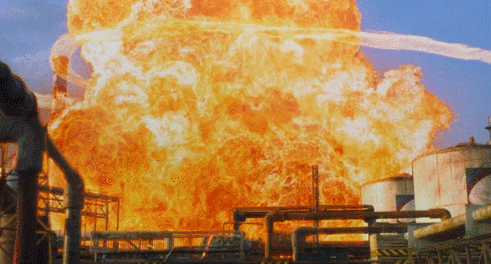
Gamera has numerous abilities that range from immense strength, unleashing and absorbing fire and plasma, flying, regeneration, converting energy, and manipulating his own body, these abilities make him a dangerous opponent. This contingency is in place should Gamera break his connection with humanity and grow reckless or a Magatama fall into dangerous hands. If a scenario such as Dr. Karbone getting another Magatama should occur, the first step is to destroy it or in a sense, strengthen Kusunagi's connection with Gamera. An alternative is to concoct a spell that drains the mana from the Magatama, breaking the user's connection with Gamera. Should the situation escalate, the next step is to deploy an experimental Mech known as the 'Titan Bat'.

Unlike other Anti-Kaiju Mechs, this one is in line with my moral restraints, even if Gamera is a monster. The mech is armed with Cryogenic technology that can freeze him. But, Gamera has a history of studying his opponents, which would prolong the confrontation. The technology within the mech is connected to a Batsuit that makes controlling it without issue, though it is fueled with a potent but draining battery. Stalling him would end in disaster and a mass loss of life. The metal alloy can withstand atomic blasts, though it is unclear if it can withstand plasma blasts.
Gamera is one of the remnants of Atlantis past and a Guardian of Earth. His death or corruption would be a tragedy, as the good he did for humanity makes him an essential ally...should we find ourselves against terrestrial and extraterrestrial threats.
#text#text post#crossover#crossover au#dc comics#dc universe#kaiju#batman#bruce wayne#gamera#gamera: guardian of the universe#gamera guardian of the universe#batman contingencies
39 notes
·
View notes
Text
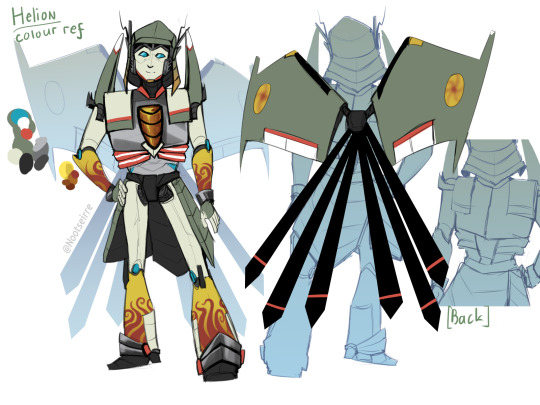
Helion's colour ref bc i kept forgetting how to draw him :'
a little rambling on his lore (may change someday):
Helion, a term in chemistry referring to the nucleus of helium. Forged in Iacon as a science lab field supervisor (specifically for anything that needs cryogenics)
Modeled for versatile and sudden movements, efficiency, and 3 different options for mobility (gliding, hovering, running) at all times.
Flight engines can run on energon, earth jet fuel (both last him a long while), or hydrogen (least effective, used as a last resort).
Runs much cooler than most other bots due to having a cryocooler built in. Carries around a type of fire extinguisher chemical blend at all times (commonly liquid nitrogen) , shoots it out of his arm or foot.
Fled from Nyon, and Cybertron as a whole, when rumors that citizen safety was being threatened, never bothered to look back or figure out who, as long as he got his colleagues and friends there out then they are safe. He does not want to return.
Never changed his Cybertronian helicopter model even when he crash landed on earth at the south pole, decided to become an industrial freezer instead. Got found by some scientists who never bothered to tell anyone out of Antarctica about his existence, they're pretty happy with him around actually!
He adores the job he had on Cybertron and is more than happy to help out the scientists, mostly because of his machine capability of processing chemicals safely for the humans and dispensing it in the exact amount they need. In turn, the scientists bring jet fuel and gives him regular maintenance and system checks.
Mostly docile and prefers to protect and flee than attack. Huge advantage withstanding extreme temperatures and small spaces doesn't guarantee durability against huge impact forces. He knows this well from observation.
The humans would refer to his stance nowadays as an anarchist due to him, while admitting to choose becoming a neutral, would rather take the government and factions that caused this mess down as a whole. He doesn't have any will to take actions as such and does not answer to nor want anything to do regarding his political stance.
Extra information not directly regarding him, but related to his lore in general:
he fled with his colleagues from Nyon, who he's not exactly close to. He barely remembers who they are anymore but he hopes they're alright, even without him to look after them on earth. He does miss his friends who didn't get to see leave from the evacuation.
the "spaceship" they used to escape was the titan who's assigned to accompany Helion's group from Iacon to other places on a regular basis. He was not fond of this titan at first but after some time drifting through space they become quite close. On earth, they got separated upon passing through the atmosphere, this titan would later be referred to as Pacific when Helion finds him again after years pass.
When Pacific does find Helion, he informed him that most of his colleagues and friends have left earth by tagging along with either Autobots or Decepticons, while some did stay on earth under either faction names. Helion feels slightly disappointed at this and asks him to leave, Pacific would not see him again for another 5 years and never spoke of the factions again with him.
Helion secretly feels a little guilty when the humans bring jet fuel to him on one of his first few critical maintenance on earth, it took quite a while for him to be assured that they're equally as happy to share things as he is with them. Sometimes, they would have sleepover parties near the base door connected to the hangar so he doesn't feel lonely.
by human standards, Helion is warm. He knows he isn't by Cybertronian standards though, he is just slightly colder than the average bot. The humans don't care about that apparently, nor did they care about the fact that he hates the ladders being used on maintenance and would rather hold up the tiny flesh beings. Seems like some of them enjoy that.
by size, Helion is about the same size as seekers, if not just being more squared and dense from his Cryocooler/ Industrial freezer alt mode kibbles. He's mostly specialized wires and tubes in a casing, thus hurting his plating won't do too much critical damage. Unless someone cuts off a number of the wires from him and doesn't return it.
his internal chemical processing build and chemical reserves actually allows him to make his own emergency fuel; hydrogen! In reverse, the same system allows Energon to be processed into Nitrogen and other chemicals, but Jet fuel is more complex to process so it makes less chemicals for him to use but lingers as fuel for long.
#transformers#transformers fanart#transformers oc#tf oc#tf ocs#Helion [tf oc]#HAHA THAT MUCH LORE?? IT'S 9PM WHAT HAPPENED.....#oh. that's my chemistry notes there.#view vault [art]#character lore#i guess?#character study#writing#and that. okay now im going to sleep.
18 notes
·
View notes
Text

Improving MgH₂ hydrogen storage with oxygen vacancy-enriched H-V₂O₅ nanosheets as an active H-pump
With the depletion of fossil fuels and global warming, there is an urgent need to seek green, clean, and efficient energy resources. Against this backdrop, hydrogen is considered a potential candidate for replacing fossil fuels due to its high energy density and environmentally friendly nature. To realize the development of a hydrogen economy, safe and efficient hydrogen storage technologies are crucial. Compared to traditional compressed hydrogen and cryogenic liquid hydrogen storage technologies, solid-state hydrogen storage is considered a safer and more efficient method. Magnesium hydride (MgH2), as one of the most promising solid-state hydrogen storage materials, has attracted attention due to its abundant elemental resources, high hydrogen storage capacity, good reversibility, and non-toxicity. However, the relatively high operating temperature of MgH2 limits its large-scale commercial application in vehicular or stationary hydrogen storage.
Read more.
#Materials Science#Science#Hydrogen#Oxygen#Vacancies#Defects#Nanotechnology#Hydrogen storage#Hydrides#Magnesium#Vanadium
17 notes
·
View notes
Photo

2023 April 6
Terran 1 Burns Methalox Image Credit: Relativity / John Kraus
Explanation: Relativity's Terran 1 Rocket is mostly 3D-printed. It burns a cryogenic rocket fuel composed of liquid methane and liquid oxygen (methalox). In this close-up of a Terran 1 launch on the night of March 22 from Cape Canaveral, icy chunks fall through the stunning frame as intense blue exhaust streams from its nine Aeon 1 engines. In a largely successful flight the inovative rocket achieved main engine cutoff and stage separation but fell short of orbit after an anomaly at the beginning of its second stage flight. Of course this Terran 1 rocket was never intended to travel to Mars. Still, the methane and liquid oxygen components of its methalox fuel can be made solely from materials found on the Red Planet. Methalox manufactured on Mars could be used as fuel for rockets returning to planet Earth.
∞ Source: apod.nasa.gov/apod/ap230406.html
105 notes
·
View notes
Text
Reason 552 Barriss should’ve been (Fulcrum) in Rebels: how much harder the Luminara episode would’ve hit if she’d been there.
Barriss had never expected to see her master alive again. She'd lived with her death for a decade and a half; Barriss had felt the Purge, and so few had survived. But she'd never been sure, and the scant hope she'd kept alive for so long had desperately wanted to believe that Trayvis's info was good, that Luminara lived, that she could find her master again. And she had. Imprisoned in a cryogenic coffin, fifteen years gone and dead, her once-master. Luminara Unduli, Knight of the Jedi Order, General of the 71st Elite Corps, Master to a traitor and heretic. Dead, just like the Republic she'd defended.
They'd put her in a force-damned sarcophagus and used her bones as a beacon, tempting survivors to their deaths. Barriss wanted to cry, to scream, to be sick. It wasn't right. Jedi burned their dead. Barriss should--what? What should she do? What could she do? There was no fuel for a pyre, no Masters to preside, no one left to mourn. No one but Barriss, and Barriss was a traitor. She could not give her a proper funeral. Luminara was dead, and still, Barriss failed her. That was all she could ever do, it seemed.
She rested her head against the cold transparisteel of the casket. It was all so wrong. She remembered her last conversation with her master in a cold, featureless visitation room of Coruscant High-Security Republic Penitentiary. Luminara had told her that the Jedi had managed to get her execution date permanently postponed, and Barriss had cried. She'd told her she was being deployed to Kashyyyk, and Barriss had cried. She'd told Barriss goodbye, and Barriss had cried. She'd done that a lot back then. It seemed she was getting back into the habit.
Tears froze on the cold surface of the coffin.
"I'm sorry," she whispered, but what she meant was, could I have saved you? If I'd been there, if I'd never Fallen, if I was still your student, would you be safe? Could I have taken the blaster bolts for you, let you get away? Is there a world where our places are inverted? "I'm so sorry, Master. I don't... I can't..."
She remembered Luminara’s smile. Her gentle, firm presence warm and welcoming even when Barriss had been at her lowest, screaming her hatred from behind cell walls. “It does not matter what you have done, Padawan,” Luminara had told her when she had finally seen the truth of the Temple bombing, sobbing on the floor of her cell. “All that matters is you see the light, change your ways and make amends. It does not even matter if you fail along the way. The dark road is treacherous and difficult to climb out of. What is important is that you try.”
Barriss Offee was not a Jedi. The Temple was destroyed, the Council murdered, the Code abandoned. She could never call herself Jedi again and know that it was truth. That did not matter, not now. What mattered was that her Master was depending on her one last time. She could not hold a proper funeral, but that didn't matter either. She would try.
She stepped back from Luminara's coffin.
She ignited her lightsabers, one white, one blue.
She slashed through the transparisteel, careful not to let the blades touch her Master.
Cold white steam materialized as freezing, fifteen-year-old air leaked out.
Luminara's corpse fell forward, into the gouged transparisteel, with a small thump.
Jedi funerals were short, simple affairs. The body was ritually cleaned, then laid out on a stone slab. Any who wished to pay their respects could come to mourn. The ceremony was held exactly three days after death and lasted perhaps fifteen minutes. Afterward, their lineage would hold a small party, remembering the fallen's life and celebrating their memory. The dead were free, released to the total harmony of the Force. There was no need for extended grief periods or complex rites. A life was to be remembered, missed, honored, not held on to.
Barriss breathed out, composing herself.
There had been so many funerals in the war; Barriss knew precisely what to say and do. Her lips moved, almost on their own.
“There is no emotion, there is peace.
There is no ignorance, there is knowledge.
There is no passion, there is serenity.
There is no chaos, there is harmony.
There is no death, there is the Force.”
She cried, and a small, blue flame ignited in her palm. She continued.
“I am one with the Force, and the Force is with me. You are one with the Force, as all things shall be. May you find justice; May you find peace. May the Force be with you.”
Her body shook with uncontrollable sobs. The flame in her hand grew larger and brighter. She cried as she pressed her hand against her Master’s cold, dead corpse and watched the fire take hold. The Force Fire left no smoke; it ate through Luminara’s body, dropping her ashes on the cell floor.
Luminara was free. It was too much. Barriss collapsed to the floor and wept.
#I couldn’t find much on Jedi funerals the only real constant was that they burned the body so I extrapolated and went off vibes#completely made up that second prayer btw it just felt right#hope this is ok it’s been YEARS since I’ve posted Star Wars fic here#shit I don’t think I ever linked my AO3#i should really get this on AO3#star wars#sw rebels#rebels#Star Wars rebels#rebels fic#sw rebels fic#sw fic#star wars fic#Barriss Offee#Barriss Offe fanfic#Barriss Offee fic#Star Wars fanfic#me when I write#luminara unduli#Jedi culture#jedi funerals
83 notes
·
View notes
Text



Released on July 7th, 2015, Dark Horse released a graphic novel by the name of Rexodus. The story of Rexodus follows the Disaurians, in-universe dinosaurs who used lava to fuel their technological advances, that had to leave the planet 64.9 million years ago because of the Black Blood, a volatile substance. During the Disaurians’ departure, the master sergeant of the legion, K’Vark, saves the ship his son is in, Kelvin Sauridian. But, Kelvin tries to go back and save him, and ends of cryogenically frozen for millions of years. 64.9 minutes from a future point, humans in the present day discover the remains of the Disaurians and the Black Blood, and it’s up to the newly reawakened Kelvin and the daughter of the paleontologist who found him, Amber Dixon, to save the Earth from the Black Blood with allies from the present day Disaurians as well.
#dark horse comics#rexodus#kelvin sauridian#dinosaurs#scifi#paleomedia#I consider this to be lost paleomedia#it even had a vr experience#but then it disappeared
4 notes
·
View notes